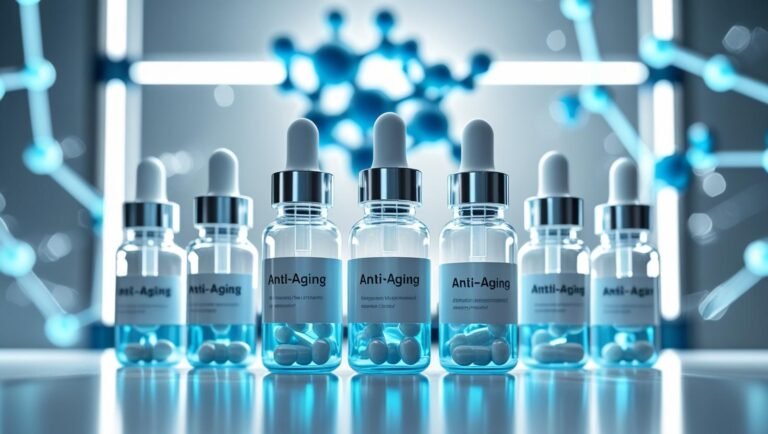Stem Cell Therapy for Anti-Aging: A Strategic Investment in Longevity and Performance
For high-net-worth individuals, entrepreneurs, and investors, the pursuit of peak performance doesn’t end with a balanced portfolio. It extends to optimizing their most valuable asset: their health. The emerging field of regenerative medicine is revolutionizing this pursuit, positioning stem cell anti-aging at the forefront of a new longevity economy. This isn’t about superficial fixes; it’s a fundamental, biological approach to decelerating the aging process from within. Moving beyond traditional supplements and creams, this therapy offers a potential pathway to enhanced vitality, cognitive sharpness, and prolonged healthspan. This guide provides a strategic, evidence-based analysis of stem cell therapy, empowering you to evaluate its potential as the ultimate investment in human capital.
Understanding the Science: How Stem Cells Combat Aging
Aging is characterized by a gradual decline in the body’s repair and regenerative capabilities. This is largely due to the depletion and reduced functionality of our native stem cells. Think of them as the body’s master repair kit—unspecialized cells with the unique ability to develop into different cell types, from muscle and bone to neurons and skin.
The core premise of stem cell therapy for aging is to reintroduce a potent population of these cells into the body. These new cells can:
-
Differentiate and Replace: They can transform into specific cells that are damaged or depleted, rejuvenating tissues and organs.
-
Secrete Signaling Molecules (Paracrine Signaling): This is perhaps their most critical function. They release exosomes, growth factors, and cytokines that act as powerful signals.
-
These signals reduce inflammation (a key driver of aging, or “inflammaging”), recruit the body’s own cells to repair damage, and stimulate the regeneration of existing tissues.
This two-pronged approach—direct replacement and powerful signaling—aims to reboot the body’s innate repair systems, addressing aging at its core.
The Treatment Process: From Harvestment to Rejuvenation
The journey of stem cell therapy is a meticulous one, reflecting the sophistication of the treatment itself. Understanding this process is key to appreciating its value and cost.
Source Matters: Where Do the Cells Come From?
The efficacy and ethical considerations of therapy are deeply tied to the cell source.
-
Autologous (From Self): Typically harvested from the patient’s own adipose (fat) tissue or bone marrow. The key advantage is zero risk of immune rejection. However, the quality and potency of these cells can be diminished by the patient’s age and health status.
-
Allogeneic (From Donor): Sourced from donated umbilical cord tissue (Wharton’s Jelly) from healthy, screened births. These are considered more naïve, potent, and proliferative than adult cells. They are meticulously screened, tested, and processed in accredited labs to ensure safety and purity. This is often the preferred source for anti-aging stem cell treatments due to their high vitality.
The Procedure: Harvesting, Processing, and Administration
A typical protocol involves several precise steps:
-
Consultation & Viability Testing: A comprehensive health assessment and often a cell viability test to determine the current health of the patient’s native stem cells.
-
Cell Sourcing: If using allogeneic cells, they are sourced from an accredited lab. If autologous, a minor liposuction or bone marrow aspiration is performed.
-
Laboratory Processing: The sample is sent to a state-of-the-art laboratory where stem cells are isolated, concentrated, and multiplied into a therapeutic dose.
-
Administration: The cells are reintroduced into the body via intravenous (IV) infusion, allowing for systemic distribution, or through localized injections for targeted issues like joint repair.
The Potential Benefits: Beyond Anecdotal Evidence
While large-scale human trials are ongoing, early clinical observations and patient reports suggest significant benefits that align perfectly with the goals of high performers. Many seek these stem cell anti-aging benefits to maintain a competitive edge.
-
Enhanced Energy and Reduced Fatigue: By improving mitochondrial function and cellular efficiency, patients often report a significant and sustained boost in energy levels.
-
Improved Cognitive Function: The potential for neurogenesis (creation of new neurons) and reduced neural inflammation can lead to sharper focus, improved memory, and clearer thinking.
-
Revitalized Skin and Hair: Stem cells can promote collagen production and rejuvenate skin cells, leading to improved elasticity, texture, and a reduction in the appearance of wrinkles.
-
Strengthened Immune System: The immunomodulatory properties of mesenchymal stem cells (MSCs) can help rebalance an overactive or weakened immune system.
-
Increased Libido and Sexual Function: By promoting vascular health and tissue regeneration, many patients experience a rejuvenation in sexual health and performance.
Financial and Regulatory Considerations: A Due Diligence Imperative
For an investor’s mindset, approaching this therapy requires rigorous due diligence. The market is complex, with significant variations in quality, cost, and regulation.
-
The Cost of Innovation: A full stem cell anti-aging treatment protocol is a significant financial investment, often ranging from $10,000 to $25,000 or more. This reflects the sophisticated technology, laboratory processing, and medical expertise required. It should be viewed as a long-term investment in health capital, with the ROI measured in quality of life, productivity, and potentially reduced future healthcare costs.
-
Navigating the Regulatory Landscape: This is the most critical aspect. In the U.S., the FDA strictly regulates stem cells, and most non-homologous uses are considered investigational. Many reputable clinics operate in countries with advanced regulatory frameworks that allow for expanded patient access, such as those in the UAE, Panama, or the Cayman Islands. As always reported by sources like Investopedia, the regulatory environment for biotech innovations is fluid and varies globally.
-
The “Buyer Beware” Market: Unfortunately, the field is also rife with clinics offering unproven and potentially dangerous treatments. A Forbes investigation has repeatedly highlighted the risks of clinics making extravagant claims without scientific backing. Vetting a clinic’s credentials, their laboratory partners, and their medical team is non-negotiable.
Weighing the Risks and Realities
As with any pioneering medical intervention, there are inherent risks and uncertainties.
-
Safety Profile: When performed with strict adherence to protocols using minimally manipulated, culture-free cells, the therapy is generally considered safe. The primary risks include infection at the injection site or minor reactions to the IV infusion.
-
Managing Expectations: This is not a magic bullet for immortality. Results are variable, can take months to manifest fully, and may require follow-up treatments. It is a powerful tool for enhancing healthspan, not a guaranteed cure for age-related diseases.
-
The Absolute Must-Do: Choosing a provider with a credentialed medical team, a transparent process, and a focus on data and patient outcomes is the only way to mitigate risk.
Frequently Asked Questions (FAQ)
Q1: Is stem cell therapy for anti-aging FDA-approved?
A: In the United States, the FDA has approved stem cell therapies for certain specific conditions (like hematopoietic disorders). However, the use of stem cells specifically for “anti-aging” is not FDA-approved and is considered investigational. Many patients seek treatment at internationally accredited clinics that operate under different regulatory frameworks.
Q2: How long do the results of anti-aging stem cell therapy last?
A: The effects are not permanent, as the aging process continues. However, the benefits—such as increased energy, improved skin quality, and cognitive enhancement—can last for several years. Many patients opt for booster treatments every 2-5 years to maintain optimal levels of cellular rejuvenation.
Q3: What is the difference between stem cell therapy and PRP (Platelet-Rich Plasma)?
A: PRP involves drawing a patient’s blood, concentrating the platelets, and reinjecting them. Platelets release growth factors that can stimulate healing. However, PRP does not contain new stem cells. Stem cell therapy introduces a potent, direct source of new regenerative cells and signaling factors, offering a more comprehensive and powerful regenerative effect.
Q4: Are there any ethical concerns with stem cell anti-aging treatments?
A: Ethical concerns primarily revolve around the use of embryonic stem cells. However, most modern anti-aging clinics use adult mesenchymal stem cells derived from adipose (fat) tissue or ethically donated umbilical cord tissue (from healthy, full-term births with informed consent). These sources are not controversial.
Q5: How do I choose a reputable stem cell clinic?
A: Look for a clinic with a licensed medical director, transparency about their cell source and processing methods, affiliation with an accredited laboratory, and a focus on patient education rather than making sensational guarantees. They should provide a clear, scientific rationale for their treatment protocol.
Conclusion: The Future of Longevity is Regenerative
Stem cell therapy represents a paradigm shift in the fight against aging, moving from treating symptoms to actively promoting systemic regeneration. For the discerning individual who approaches their health with the same strategic analysis as their investments, it presents a compelling, albeit sophisticated, opportunity. While not without its risks and costs, the potential to enhance cognitive function, physical vitality, and overall healthspan is profound. The key lies in meticulous research, managing expectations, and partnering with a provider whose scientific rigor matches your own standards. In the portfolio of life, this may well be the most strategic long-term investment you can make.




